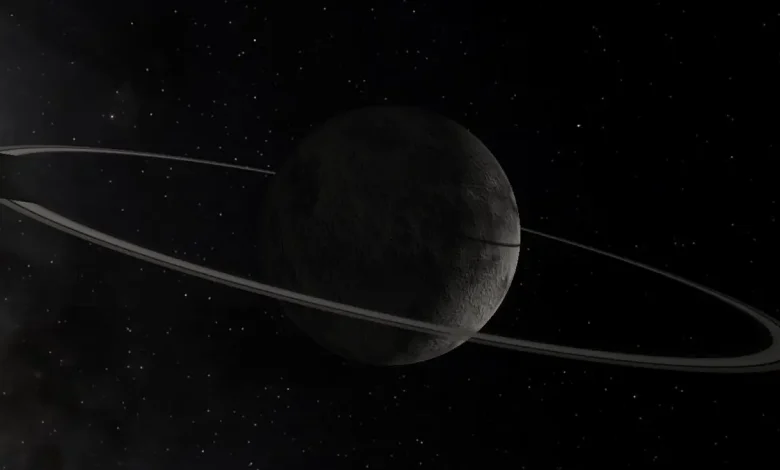Chiron may be growing its own rings between Saturn and Uranus

Far beyond Saturn’s orbit, sunlight barely reaches the region where Chiron travels. Despite the distance and cold, the object has proven unexpectedly active. What was once thought to be a silent asteroid now shows comet-like behavior, including bursts of light and a halo of escaping dust.
Chiron belongs to a group called centaurs, icy objects that wander between Jupiter and Neptune. They combine the rocky composition of asteroids with the volatile ices of comets. Chiron’s path takes about 50 Earth years to complete a single orbit around the Sun, and since its discovery in 1977, observers have noted several unexpected brightenings.
These brightenings are linked to activity beneath the surface. When sunlight penetrates Chiron’s crust, frozen gases can sublimate, blasting dust and ice into space. Over time, that material drifts outward and settles into the object’s equatorial plane.
The most detailed look at this process came from a stellar occultation, when Chiron passed in front of a distant star. By watching how the star’s light dimmed and recovered, astronomers could reconstruct the structures around Chiron. The observations revealed not a simple coma, but multiple ring-like features orbiting the body.
A rare glimpse of rings forming in real time
In September 2023, thirty-one telescopes across South America turned toward Chiron. The 1.6 m (5.2 ft) Perkin–Elmer telescope at Pico dos Dias Observatory in Brazil captured light at ten frames per second, resolving tiny fluctuations as the star blinked out and reappeared.
Analysis of the light curves showed sharp, repeating dips. These were the signatures of three narrow rings, located at roughly 273, 325, and 438 km (170, 200, and 270 miles) from Chiron’s center. Their positions matched features seen in earlier occultations in 2011, 2018, and 2022, suggesting long-term stability.
But the new data also contained something that earlier observations did not. Superimposed on the narrow rings was a broad, faint disk stretching from about 200 to 800 km (120 to 500 miles). Its absence in previous measurements implies that it formed only within the past decade.
Even farther out, researchers detected a dim feature nearly 1 380 km (860 miles) away, beyond the classical Roche limit. That region should be unstable for ring material, which normally clumps into a moon. Yet this outer structure remains diffuse, hinting that Chiron’s surroundings are in active flux.
How debris builds a miniature ring system
Scientists suspect that recent activity on Chiron released large amounts of dust and ice. One explanation is a violent outburst, when subsurface ices rapidly expanded and vented gas into space. The material would have spread around the body and slowly flattened into an equatorial disk.
Another scenario involves the breakup of a small satellite. A moon about 0.3–0.5 km (0.2 to 0.3 miles) in radius could yield roughly 1 x 10¹¹ kilograms of debris, comparable to the estimated mass of Chiron’s disk.
Collisions provide a third possibility. Chiron may have passed through a swarm of debris left by another centaur or an older fragmentation event. Even a moderate-velocity impact could have supplied enough ejecta to create transient rings.
Each process would produce a mix of dust and ice, consistent with spectra collected by the James Webb Space Telescope in 2023. JWST detected methane and carbon dioxide around Chiron, but no carbon monoxide, a pattern implying that volatile ices remain buried until released by sudden heating or disruption.
What the models reveal about Chiron’s structure
To test the origin of the observed features, astronomers modeled two geometries: spherical shells of dust, similar to a comet’s coma, and a flat equatorial disk with embedded dense rings. The equatorial disk fit the data far better, reproducing the timing and depth of each brightness drop.
The confined rings appear thin and semi-transparent. Their widths range from less than one kilometer to several tens of kilometers, and their optical depths indicate collections of solid particles rather than a smooth gas cloud.
Chiron’s low density of roughly 1 100 kg/m³ (68.7 lb/ft³) gives it a weak gravitational field, yet the rings remain in orbit. Their persistence is likely maintained by resonances with the object’s 5.9-hour rotation period. The two inner rings lie close to 1:2 and 1:3 spin–orbit resonances, zones that can stabilize orbits by synchronizing rotation and revolution.
This resonance pattern resembles behavior seen in planetary rings, such as those around Saturn and Neptune. Despite its small size, Chiron demonstrates the same physical principles that govern much larger systems.
A window into the Solar System’s early dynamics
Before Chiron, only three small worlds were known to carry rings: Chariklo, Haumea, and Quaoar. Each discovery challenged the idea that only giant planets could sustain such structures. Chiron extends that list while adding a crucial new element, change over time.
The evolving disk around Chiron may represent a middle stage between a chaotic debris cloud and a mature ring system. Observing it offers a living example of processes that likely shaped ringed planets billions of years ago.
If future observations confirm that Chiron’s rings are spreading or changing opacity, it would mean scientists are watching a ring system assemble in human time. Such direct evidence has never been recorded before for any celestial body of this size.
Understanding how small bodies generate and maintain rings may also clarify how early planetary disks evolved. The same mechanics that flatten dust into equatorial planes around centaurs can apply to young planets forming moons and satellites.
What comes next for astronomers
Proving that Chiron’s rings are actively evolving will require more occultation events observed from multiple continents. By tracking subtle shifts in ring position, width, and brightness, astronomers can determine whether dust and ice are moving outward or being replenished.
If changes appear between successive years, they would confirm ongoing activity. Researchers already plan coordinated campaigns to capture future occultations, using both ground telescopes and space-based instruments.
In the longer term, a dedicated spacecraft flyby could sample particles directly, mapping their composition and structure. Such a mission would reveal whether Chiron’s environment is transient or the beginning of a stable ring system.
Until then, Chiron remains a rare natural laboratory. Within its faint halo of debris, scientists see echoes of the early Solar System and a reminder that even the smallest worlds are far from static.
References:
1 The Rings of (2060) Chiron: Evidence of an Evolving System – C. L. Pereira, F. Braga-Ribas, B. Sicardy, R. Leiva, M. Assafin, B. E. Morgado, J. L. Ortiz, P. Santos-Sanz, J. I. B. Camargo, G. Margoti – IOP Science – October 14, 2025 – https://iopscience.iop.org/article/10.3847/2041-8213/ae0b6d – OPEN ACCESS





